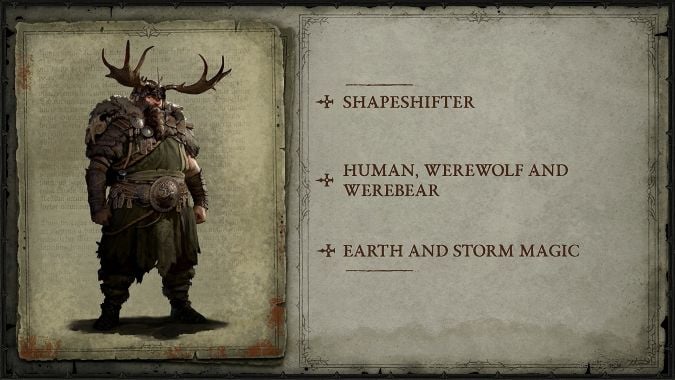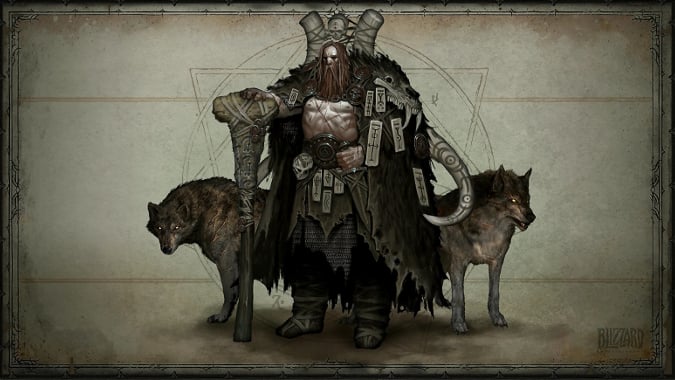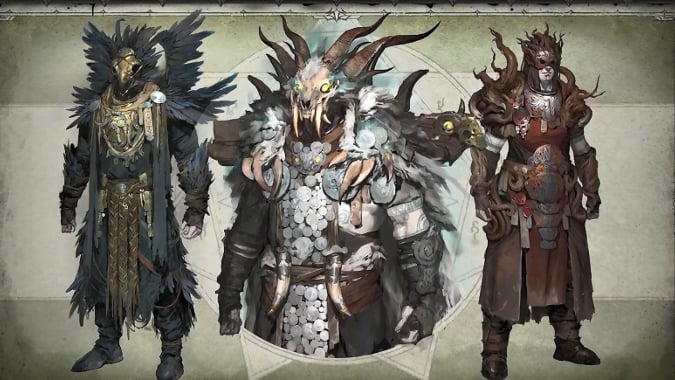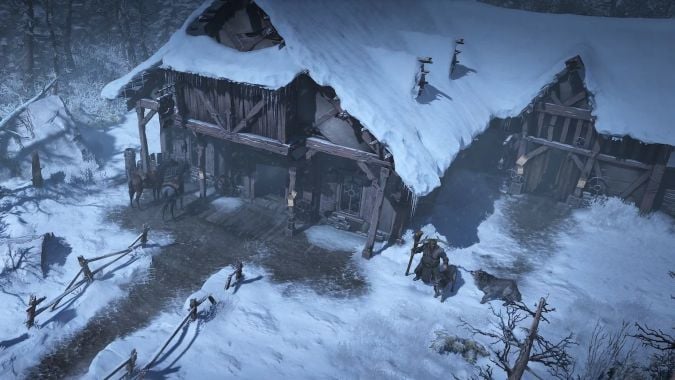Everything we know about the Diablo 4 Druid

After a nearly 20-year-long hiatus, the Druid is back in the hands of players for Diablo 4 and was one of three classes in the floor demo at this year’s BlizzCon. Blending shapeshifting and nature-oriented spellcasting with raw physical presence, D4‘s Druid is a massive beast that nonetheless has some extra tricks up his sleeves. So what do we know about the Barbarian’s long-lost cousin?
Key Details
- Basic abilities generate Spirit, which powers other abilities
- Most other abilities limited by cooldowns
- Shapeshifts into a Werewolf or Werebear form to perform physical attacks
- Attacks from range with earth and storm magic
- Summons animal/plant companions to aid self and attack/debuff enemies
When the Druid last appeared, it was an expansion class in 2001’s Diablo 2: Lord of Destruction, alongside the Assassin. He was a jack-of-all-trades, having a tree for nature-oriented magic that competed with the D2 Sorceress, one for shapeshifting that made him a melee powerhouse like the original Barbarian, and one for summoning spirits that put him in a class with the minion-heavy Necromancer.
With how much D2‘s resulting gameplay relied on specialization, however, the Druid didn’t get to lean into this flexibility as much as his counterpart in World of Warcraft; since each of the Druid’s trees felt like a stripped-down version of another class, there weren’t many compelling reasons to pick him over one of those other classes, aside from aesthetics. As a launch class in D4, however, it’s highly likely that the Druid’s strength in versatility will set him apart from the other classes and allow him to eke out his own corner.

Druid skills in Diablo 4
Similar to Diablo 3‘s class design paradigm, the Druid’s various button-press abilities are split among six categories:
Basic
These are a mix of physical and magical attacks that generate Spirit and each have a bit of utility besides. Good primary attacks with a bit more diversity between them than equivalents for other classes in D3.
- Earthspike (Earth Magic): Impales the first enemy it hits for physical damage, and generates 12 Spirit. It also buffs your chances to deal a Crushing Blow by 10%.
- Shred (Shapeshifting): Puts you in Werewolf form to slash an enemy for physical damage, with a 30% chance to strike twice. It also generates 8 Spirit.
- Storm Strike (Storm Magic): Lets you go WoW Enhancement Shaman, dealing Lightning damage to your melee target and up to three nearby enemies. It also generates 12 Spirit.
- Maul (Shapeshifting): Puts you in Werebear form to pounce and maul an enemy for physical damage, generating 18 Spirit and granting a Fortified shield for a certain amount. While Fortified, you take 30% less damage until the Fortified amount is depleted.
- Wind Shear (Storm Magic): Deals physical damage to an enemy, generates 12 Spirit and increases your movement by 5% for three seconds. This can be stacked up to 30%, so it’s a great way to replenish your Spirit and make your way to the next enemy quickly.
Spirit
These are your big-damage spenders, which are all large area attacks that can hit multiple enemies. They cost Spirit to use.
- Pulverize (Shapeshifting): Spend 30 Spirit to turn into a Werebear and do a ground slam that deal Physical damage to nearby enemies.
- Landslide (Earth Magic): Spend 30 Spirit to summon three pillars of earth, crushing enemies for Physical damage. There’s an additional 10% chance to deal a Crushing Blow.
- Tornado (Storm Magic): Spend 20 Spirit to summon a vortex of wind that spins out in a random direction, dealing Physical damage every second to enemies struck.
- There is a fourth unknown Spirit ability in the floor demo that may or may not become something later.
Defensive
Despite the name, half of the abilities listed here are also attacks, but all of them grant some defensive utility, either by passively reducing your damage taken, debilitating enemies so they can’t damage you as much, or straight-up healing you from damage you’ve taken.
- Cyclone Armor (Storm Magic, passive): A passive-only ability that grants 15% ranged damage reduction. When a ranged enemy hits you, there’s a 15% chance they get knocked back in return.
- Earthen Bulwark (Earth Magic, 15s CD): Rocks protect your body for three seconds, giving you Unstoppable and absorbing some damage. When the absorption expires, the rocks explode, dealing damage based on the remaining absorption value to nearby enemies.
- Trample (Shapeshifting, 10s CD): Shift into Werebear and bulldoze enemies in front of you, dealing physical damage and stunning them for 1.6 seconds.
- Debilitating Roar (Shapeshifting, 20s CD): Shift into Werebear and roar, reducing attack speed of nearby enemies by 22% for five seconds.
- Ravenous Bite (Shapeshifting, 10s CD): Shift into Werewolf and nom an enemy, dealing damage to them and healing you in return.
Wrath: These are additional, cooldown-delimited attacks that dish out additional damage. The category is pretty small, so it feels ill-defined at the moment.
- Hurricane (Storm Magic, 15s CD): Form a hurricane around you that deals damage to nearby enemies over eight seconds.
- Boulder (Earth Magic, 8s CD): Summon THE BOULDER (Editor’s note: Not actually what happens) which knocks back enemies, dealing damage with each hit. Tack on an additional 15% chance to deal a Crushing Blow.
- The floor demo had space for two additional Wrath abilities that were unknown at the time, so we’ll see.

Companion: These skills are your selection of animal and plant minions, all of which have a passive and activated effect. The active effects are limited by cooldowns that currently range from short (8s) to medium length (30s).
- Wolves (Companion, 8s CD): Two wolves roll around to nom enemies at your side. Activating the ability has them focus on a specific enemy. Generally, they have a 50% increased chance to critically hit their targets.
- Ravens (Companion, 30s CD): An unkindness of ravens hover over you, occasionally pecking enemies for some damage. Activating the ability directs the ravens to swarm a specific area. Enemies in the area take heavier damage than the passive effect, and also gain Vulnerability for six seconds.
- Vine Creeper (Companion, 15s CD): A vine creeper occasionally pops out of the ground to poison a nearby enemy for some damage over 8s. Activating the ability directs the creeper to strangle enemies in a target area, poisoning them for heavier damage over six seconds while also stunning them for two seconds.
- There was a fourth unknown Companion skill listed in the floor demo version. I’m pulling for BEES.
Ultimate: These are juicy long-cooldown (50-90s) abilities that dramatically change the battlefield for a brief period through their effects.
- Cataclysm (Storm Magic, 90s CD): Spawns a swell of tornadoes that follow you around, knocking back enemies and dealing lightning damage.
- Grizzly Rage (Shapeshifting, 50s CD): Gives you five seconds of being a Werebear with form-specific abilities, a bunch of bonus Spirit generation, and the Unstoppable status immunity.
- Petrify (Earth Magic, 50s CD): Stuns nearby enemies for five seconds. Damage breaks the effect, but deals an additional hit of damage when it does, as well as potentially hitting as a Crushing Blow.
- There was a fourth unknown Ultimate ability in the floor demo version. Something along the lines of a Stampede of animal companions sounds plausible, but no evidence of that yet.
In addition to the ability categories of the Druid, several mechanics show up repeatedly across different abilities, which bear (HA!) being highlighted:
- Fortified: Some abilities grant the Fortified status, along with a certain amount of health. While Fortified, you take 30% less damage until the Fortified amount is depleted.
- Crushing Blows: Some abilities (and Affixes) grant a chance to deal a Crushing Blow. While it’s not immediately obvious what a Crushing Blow does in Diablo 4, prior games in the series have used the same term to refer to an attack that deletes a percentage of the target’s maximum health. Notably, this was incredibly rare and hard to build around in D2, and was never implemented completely in a live version of D3, though it did show up during some beta periods before being quietly removed.
- Unstoppable: Unstoppable is immunity from any effect that would impair control of your character. If you become Unstoppable while one of those control-impairing effects is active, it’s removed, and no new effects can be applied while you’re Unstoppable. This would likely apply to stuns, confusion, and possibly movement-impairing effects like slows or roots.
- Vulnerability: Like the debuff version of Fortified, there’s a Vulnerability value when the status is inflicted by an attack. When an enemy is Vulnerable, they take an additional 30% damage until the Vulnerable amount is depleted. However, the effect is temporary, so if you don’t deal all of the Vulnerability damage within that window, the effect dissolves and they’re back to taking regular damage.

Druid talents in Diablo 4
Similar to passives in D3, talents modify your existing abilities in a meaningful way. This can be a broad effect, like Predatory Instinct increasing your damage to nearby enemies, or specific to a certain shapeshift form, like Werewolf attacks gaining a proportional poison effect. Then you’ve got broader talents like Call of the Wild, which has a distinct effect depending on which animal Companion you have out. Some even modify based on the aforementioned mechanics, like Primal Resonance, which enhances Crushing Blow damage.
Some key talents worth mentioning:
- Iron Hide/Lupine Swiftness: These two talents work in a similar manner, by providing a passive benefit (damage reduction increase/movement speed increase) while you’re in a particular shapeshift form (Werebear/Werewolf) and for three seconds after you leave that form. Both talents help to extend the specific benefits of the originating form into other shapes, which in turns helps encourage frequent shifting.
- Overpower: One of several “hit effects” that describe abilities that have a chance to trigger when they hit, Overpower specifically can knock down enemies that are already slowed. Presently the Druid doesn’t appear to have any abilities that apply the slow status, but I imagine we’ll see that iterated on in the future.
- Eye of the Storm: Critical strikes with Storm skills increase the critical strike chance of non-Storm skills. This is something that feels part and parcel to the potential versatility of the Druid, as it encourages using Storm skills to potentially double-dip on your overall critical strike chance stat.
- Earthen Might: By contrast to Eye of the Storm, though, this talent causes enemies hit by Earth skills to take more damage from Earth skills. So the option to use a variety of abilities is there, but the option to specialize in one kind of magic and becoming a powerhouse in that specific kind of damage is there as well.
In a way, these talents feel like a blendering of the skill runes and class passives we saw in D3. You have the functionality of altering an ability’s properties in a meaningful way (though perhaps less in the form of visual effects, as many D3 talents did) but you also have broader effects that engender a greater sense of synergy between different kinds of abilities. If you want to be a Shapeshift expert who can take a lot of punishment, you can do that, but if you want to be an Earth caster who aims to land lots of Crushing Blows, there’s ways to do that as well.
For a full list of everything offered in the Druid kit during the BlizzCon show floor demo, you can look at Wowhead’s overview. As we learn more about the D4 Druid gameplay, however, we’ll keep updating this page with more information.

Natural history
Within the lore of Sanctuary, the Druids shared their origins with the Barbarian tribes, and shared their charge to protect the sacred mountain of Mount Arreat against any who would dare plumb its mysteries. Where the Barbarians did this through honing their martial prowess, the Druids did it through embracing their connection to the natural world, turning both flora and fauna into their weapons and allies against evil. Doing so meant disconnecting themselves from the societies of men, however, and consequently the Druids have been only very rarely encountered outside of the wild forests of Scosglen.
For those of you who came into the franchise with Diablo 3, it is quite likely your closest brush with the Druids came when the Shrouded Moors were added in Patch 2.6.0. These moors are part of the Scosglen area, and the Night Howler enemies encountered there are suggestive of a connection with the werewolf form that the D2 Druid could take. In World of Warcraft Worgen history, Druids invented the werewolf-like and transferable “Pack Form” as a new weapon against the Burning Legion during the War of the Ancients, but it was deemed too dangerous and was sealed away until recent history. If one takes a cue from this, one could conjure a narrative that explains both where the Night Howlers came from and why the Druids never came out of the woods during those big world-threatening conflicts depicted during Diablo 3 and Reaper of Souls.
Of course, knowing that Diablo 4 takes place later demonstrates that at least one person from the Druid colleges has survived to carry on Fiacla-Géar‘s traditions. If you have question about the Druid in Diablo 4, let us know in the comments and we’ll see if the answer is out there. If not, we’ll just need to be patient — but check back often!
Please consider supporting our Patreon!
Join the Discussion
Blizzard Watch is a safe space for all readers. By leaving comments on this site you agree to follow our commenting and community guidelines.
 @unlimitedBLACK
@unlimitedBLACK




